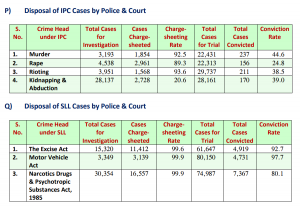
Crimes against women in India: The National Crime Records Bureau data brings out a scary picture of India, a country where women are revered as goddesses. Most women between ages 18 to 30 are vulnerable and are not even safe in their homes as they are targeted by husbands, relatives or friends. Despite various rules and regulations, evil social practices such as dowry, genital mutilation continue. More than a third of the reported cases fall in the category of cruelty by husbands or relatives.
Assam has the highest rate of crimes against women in 2021. Odisha, Haryana, Rajasthan, Maharashtra, West Bengal and Telangana are also among worst places for women. Uttar Pradesh comes on top in terms of highest number of cases registered. There has been a 40% increase in crimes against women and children in the national capital territory of Delhi in 2021. The rate has risen by over 15%, the NCRB data says.
Crimes against women
Last year alone, New Delhi saw over 14,000 cases of crimes against women, says the NCRB report. However, these are only reported cases and one cannot ignore the fact that most of the cases go unreported due to economic and societal pressure. The situation is especially dismal in Delhi and other cities stand in stark contrast with the capital. For example, Bengaluru and Mumbai saw 3,127 and 5,543 cases, respectively.
ALSO READ: UGC woos foreign universities with autonomy promise; chokes the best at home
While trauma from family members is the topmost category of reported cases, assault on women with an intent to outrage her modesty, kidnapping and abduction and rape are other categories of violence.

Socio-economic reasons for crimes
There are various reasons that contribute to the rising number of crimes against women. Men’s agreement with patriarchal and sexist notions and hostile attitude are causes. In fact, aggressive and violence-supportive behaviour among men is not called out in certain societies due to which it is considered okay for men to be violent towards their partners. Many Bollywood movies such as Thappad and Darlings have also taken up the issue recently, depicting protagonists who call out such behaviour.
Schooling in India needs to be holistic considering the fact that the country is the world’s second most populous country. In schools and colleges, precious little is done towards gender sensitisation and creating awareness about disparities. Only those who study liberal arts or law courses during higher education are sensitised towards gender issues.
There are set norms for gender and sexuality, and most of the times men and women both are punished for deviating from these. There is male chauvinism and domination in relationships. Women who refuse to accept it are often at the receiving end of hatred from their partners. Apart from gender normatives that lead to crimes against women, low socioeconomic status, poverty and unemployment have also been identified as causes of hate crimes. Alcohol and substance abuse and personality traits are also contributing factors.
Violence against women constitute a large share of human rights violations and is perpetuated by the power imbalance between men and women. It affects women’s health and stops them from effectively executing their social roles which, in turn, results in loss of opportunities. Violence against women is prevalent among all social and economic strata of the society.
ALSO READ: Two landmark deals will transform green hydrogen industry
Gender violence is rooted in the cultural and institutional social structures. Discriminatory rules, customs, traditions, laws and misogynistic language are examples of structural violence against women. These structures influence both conscious and subconscious behaviour. People grow up in these structures preserve them, leading to perpetuation of sexism and its expressions.
Ineffective laws, legal system
While there are various laws in place to prevent sexual harassment, these have done little to protect women. And then there are times when politico religious factors have contributed to injustices to women as in the case of Bilkis Bano whose tormentors got freedom after some years in prison.
The increasing polarisation between religious communities is becoming another cause of concern, especially for women who are mostly in the line of fire in the battle between men. Since time immemorial, women have been at the receiving end of hatred. Law and punishment become ineffective, when implemented selectively.
Art and art forms can help create awareness among people. The entertainment industry in India has fared poorly in serving women’s interests. Bollywood is often criticised for problematic portrayal of relationships where songs normalise stalking and catcalling. Even the lyrics of some Bollywood songs trivialise the issues of gender violence and men are often found dancing to these problematic, but catchy tunes.
The onus is on the film industry to resolve the issue. Schools and other educational institutions must make it a priority to sensitise children at a young age. The government must shift its focus to protecting women by upholding laws above religion and caste and creed.
For the entire country, there was a 7.6% fall in the crimes registered compared with the previous year. The number of crimes per lakh people fell to 445.9 in 2021 from 487.8 in the previous year. One cannot discount the fact that most crimes are not reported in several states. The NCRB report has admitted this shortcomings of its data.
